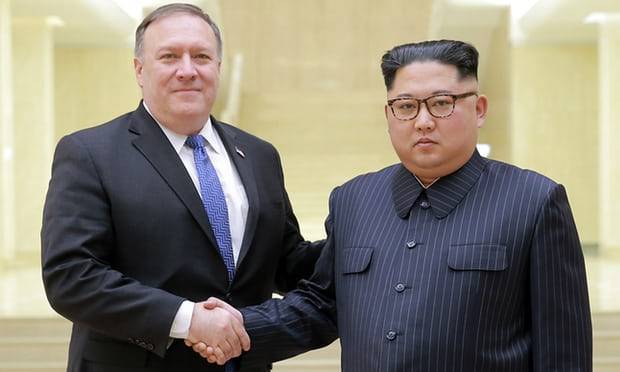The secretary of state is expected to meet Kim in person in Pyongyang, according to the White House, though details of the agenda have not yet been released. Pompeo, on his third visit to the North Korean capital, is expected to press Kim on a recent report suggesting that far from beginning the process of denuclearisation, North Korea was making “rapid upgrades” to its Yongbyon nuclear complex.
Unnamed US intelligence officials also concluded that North Korea does not intend to completely give up its nuclear stockpile.
Pompeo will also use his visit to consult and reassure Washington’s allies in the region, with meetings planned with Japanese and South Korean officials in Tokyo on Sunday. Japan has voiced support for the leaders’ Singapore declaration, but reacted cautiously to Trump’s decision to cancel a joint US-South Korea military exercise scheduled for August.
Pompeo must establish how far North Korea’s nuclear and missile programmes have advanced before US officials can even attempt to draw up a potential timeline for America’s central demand – their complete, irreversible and verifiable dismantlement [CVID].
At present, the US has no reliable information on where all of North Korea’s production and testing facilities are located or the size of its ballistic inventory.
In a tweet this week, Trump said Washington and Pyongyang had been having “many good conversations” with North Korea over denuclearisation. “In the meantime, no Rocket Launches or Nuclear Testing in 8 months, he said. “All of Asia is thrilled. Only the Opposition Party, which includes the Fake News, is complaining. If not for me, we would now be at War with North Korea!”
Sceptics have pointed out that Kim no longer believes such tests are necessary now that the North has successful developed an intercontinental ballistic missile, and that dismantling North Korea’s missile and nuclear infrastructure represents a much tougher diplomatic challenge that could take years and cost billions of dollars, if it happens at all.
“Denuclearisation is no simple task,” Daryl Kimball, executive director of the Arms Control Association, wrote in a commentary. “There is no precedent for a country that has openly tested nuclear weapons and developed a nuclear arsenal and infrastructure as substantial as the one in North Korea to give up its nuclear weapons.”
Experts have played down Trump’s upbeat appraisal of his 12 June meeting with Kim in Singapore, where the leaders made a loose commitment to work towards the denuclearisation of the Korean peninsula and agreed goodwill measures such as the possible return of the remains of US soldiers from the 1950-53 Korean war.
There are signs Pompeo might abandon all-or-nothing demands for CVID and replace them with incremental steps that South Korea has reportedly suggested would be more likely to secure Kim’s cooperation.
Washington has also come to accept that securing Chinese and Russian cooperation would be easier if it backed away from CVID in early talks with North Korea.
“The choice was either bend it or break it,” a US official told Reuters. Patrick Cronin of the Center for a New American Security said. “The US may be exploring the degree to which he will dismantle major programs within the coming months, and if dropping some language to do this is required, Washington seems willing to do that at this point.”
It remains to be seen if Pompeo will present Kim with a timeline for denuclearisation. National security adviser John Bolton’s claim that North Korea could complete that goal in the space of a year was met with widespread scepticism, even by administration officials.
Earlier this week, state department spokeswoman Heather Nauert declined to give a timeframe for North Korea’s denuclearisation, saying “I know some individuals have given timelines; we’re not going to provide a timeline for that. A lot of work is left to be done, certainly. We go into this eyes wide open.”
More about: #Mike-Pompeo
















































